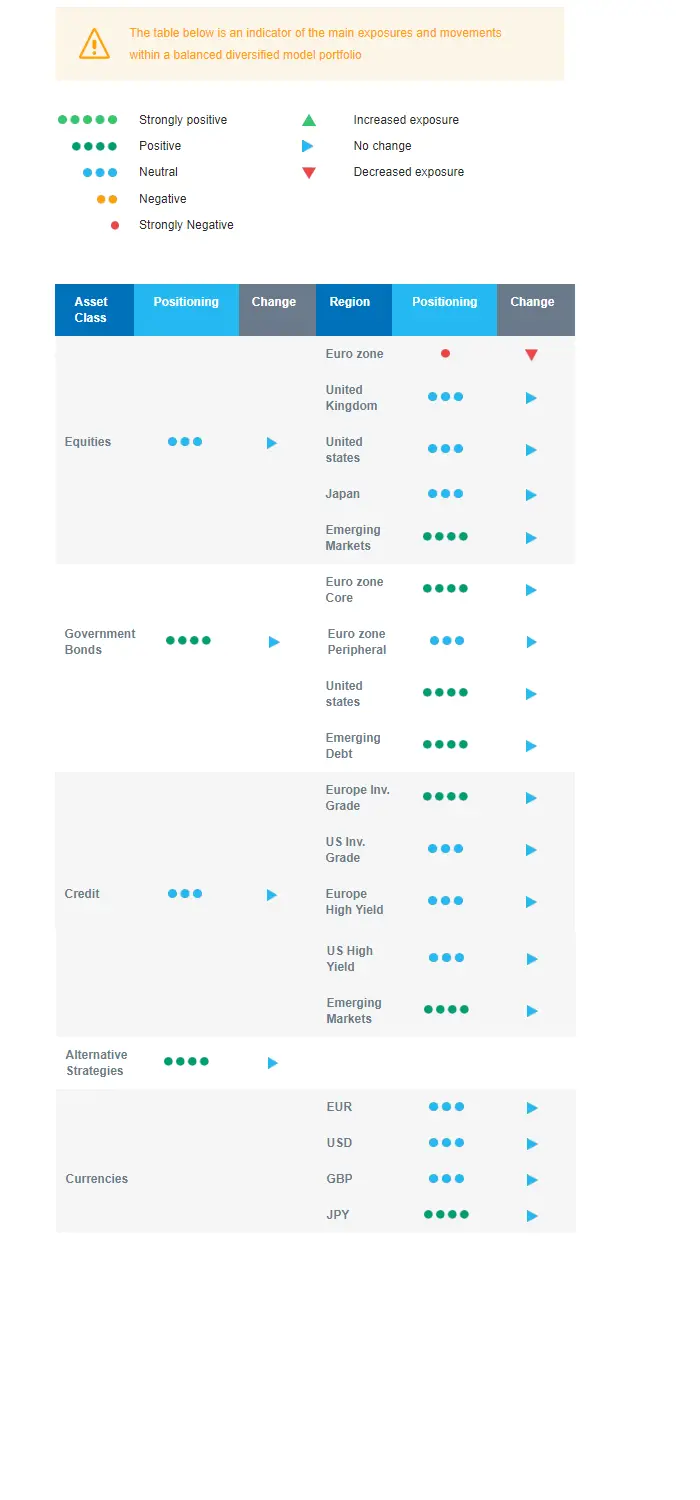Last week in a nutshell
- Equities and government bonds ended a difficult third quarter registering their worst month of the year as investors digested the hawkish central bank messages.
- First estimates of the euro zone inflation rate and the US PCE prices confirmed the disinflation trend was on track on both sides of the Atlantic.
- In the US, surveys showed that consumers are unsure about the trajectory of the economy while consumption continued to rise faster than income, implying a falling saving rate.
- In Germany, the Ifo business survey supported the view that the slowdown in euro zone GDP growth could have troughed.
What’s next?
- The US starts the last quarter of 2023 avoiding a government shutdown until November 17th. Of note, aid to Ukraine will need the passage of a separate package.
- The Bureau of Labor Statistics will release the September job report, which is expected to confirm that the trend in US job creations has fallen below 200k.
- On the data front, the publication of final PMI, PPI, retail sales and industrial production are due for key countries giving investors a better appreciation of the economic momentum and regional divergences.
- Central banks are meeting in Australia and India while several central bankers will speak, including Fed Chair Jerome Powell and ECB President Christine Lagarde.
Investment convictions
Core scenario
- In terms of economic growth, the landing has started in the US while the ongoing dataflow is weak in the euro zone. Meanwhile, in China, we see growth losing momentum but triggering more action - in small doses - from authorities.
- The inflation path is on a decelerating trend. In the US, the downward trend is set to resume in Q4 whereas in Europe, the ECB will remain vigilant while core inflation is now at 4.5%. China is still a candidate for exporting deflation to the world.
- The persistent hawkish bias by central banks in developed markets is impacting financial conditions and assets. The credit channel is restrictive as central banks keep their policy rates high for longer than markets have hoped for.
- In summary, we have a scenario of range bound markets: Activity deceleration puts a cap to the upside, but the likely end of central banks’ tightening cycle could help building a floor.
Risks
- A temporary overshoot in longer-dated bond yields present a risk for fixed income holdings and duration-sensitive equities.
- The steepest monetary tightening of the past four decades has led to significant tightening in financial conditions. Financial stability risks could return.
- A rise in the price of oil and a stickier inflation path than already expected could force central banks to hike even more, which implies that the growth outlook is tilted to the downside.
- While economic policy uncertainty is declining in Europe from last year’s excessive levels, the US elections of November 2024 are looming.
Cross asset strategy
- While keeping a neutral positioning on equity, we have increased our underweight euro zone equity as the market showed increasing signs of weakness, especially relative to other regions.
- While shunning the euro zone is currently our strongest conviction, we expect a range-bound global market and consider limited upside potential. At current levels, an economic outcome with a softish landing seems already priced in for equities. We focus on harvesting the carry and are long duration.
- We have the following investment convictions:
- Our positioning on equities is defensive at the current juncture. We are neutral on US equities and are strongly negative on euro zone equities as the restrictive monetary policy is likely to outlast investors’ expectations.
- We believe in the upside potential of broad Emerging markets, which should benefit from improving economic and monetary cycles vs developed markets, while valuations remain attractive.
- We prefer defensive over cyclical names, such as Health Care and Consumer Staples, as cyclicals are already pricing a strong improvement and economic recovery. In addition, defensive sectors have better pricing power while further margin expansion is unlikely.
- Longer-term, we favour investment themes linked to the energy transition due to a growing interest in Climate and Circular Economy-linked sectors. We keep Technology in our long-term convictions as we expect Automation and Robotisation to continue their recovery, albeit at a reduced pace compared to the first three quarters of this year.
- In the fixed income allocation:
- In government bonds, we remain positive on US and EU duration. While in the US, the landing has started, there is no reason for the Fed to become dovish yet. By the same token, there is less growth in the euro zone, but inflation is still too high for the ECB.
- In credit, we focus on carry and are positive on Investment Grade, especially by European issuers. The conviction has been strong since the start of the year as carry-to-volatility is attractive.
- We are more prudent on high yield bonds: After rallying in 2023, spreads are now close to historical levels. Tightening credit standards should be a headwind.
- We are positive on Emerging debt (hard and local currency) as the bonds continue to offer the most attractive carry. The accommodative stance of the central banks is positive for the asset class. As investor positioning is still light, this should represent a tailwind for local currency debt.
- We hold a long position in the Japanese Yen and have exposure to some commodities, including gold, both are good hedges in a potential risk-off environment.
- On a medium-term horizon, we expect Alternative investments to perform well.
Our Positioning
Our convictions translate into a long duration mostly via European and US government bonds, a focus on credit that brings carry, i.e., investment grade and emerging debt while being more cautious on high yield and lastly a neutral equity stance but with regional nuances. We are positive on emerging equities, amid dovish local central banks and potential further Chinese stimulus. We recently increased our underweight regarding euro zone equities. We are neutral US equity as the positive US economic scenario seems priced in for equities, capping further upside. In terms of sectors, our “late cycle” asset allocation strategy is axed around defensive sectors over cyclicals ones, which are priced for a recovery.

